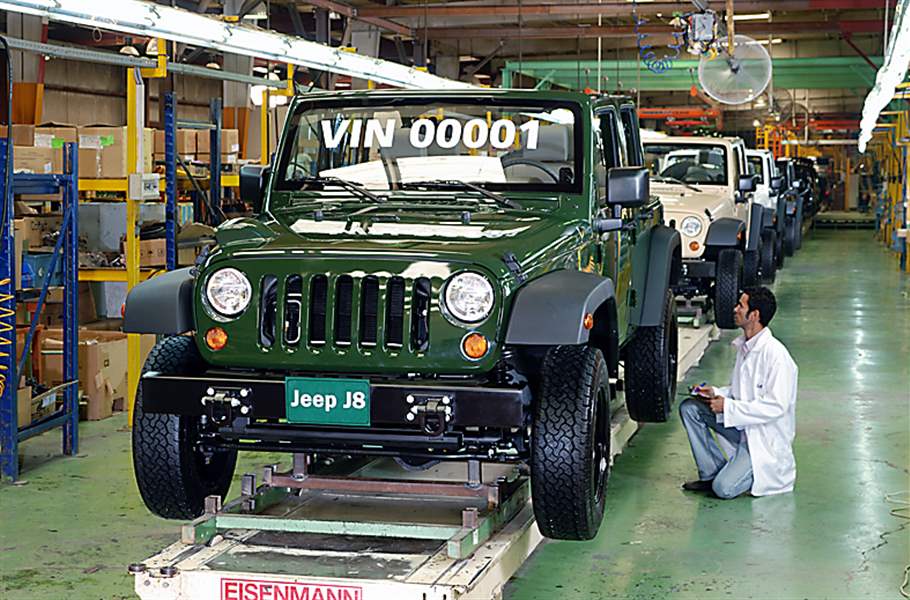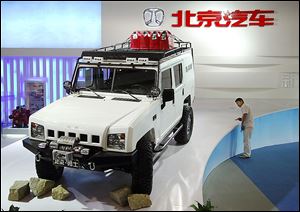
Worldwide clamor for Jeep, but most vehicles U.S.-made
Experts say it makes sense for brand to expand production
11/4/2012
Chrysler has a joint venture in Cairo, where knock-down kits of the Jeep Cherokee, Jeep Wrangler Unlimited, and a military-purpose Jeep J8 are assembled, but production is low.

A Jeep made by Beijing Automotive Industry Corp. is on exhibit in Beijing in 2009. Chrysler’s joint venture with China began in 1985 but ended with the automaker’s bankruptcy in 2009.
In 1983, Jeep did something revolutionary.
Its parent company, then American Motors Corp., purchased a stake in a Chinese automaker, forming a joint-venture to produce Jeeps in China. It was the first such arrangement in China.
Cherokee production started there in 1985. When Chrysler bought out AMC in 1987, Beijing Jeep went with it. The factory eventually produced the Grand Cherokee, Chrysler 300, and Chrysler Sebring.
The joint venture was ended with Chrysler’s 2009 bankruptcy.
But in spite of its trailblazing, Jeep didn't establish a strong foothold in China, which has become the world’s largest automotive market.
"It's always been at the whim of the fortunes of whoever the parent is,” said Michelle Krebs, senior analyst at Edmunds.com. “Not that anyone didn't see its potential, but there was not funds or not the will to dedicate the funds to exploit that advantage."
Currently, Jeeps sell in more than 120 countries around the world, including China. They're nearly all built in factories in the United States.
Autoworkers in Toledo build the Wrangler and will soon start producing Jeep's successor for the Liberty. Grand Cherokees are built in Detroit. The Compass and Patriot are made in Belvidere, Ill.
Jeep sold 532,972 vehicles globally through September. The majority are sold in North America, with U.S. sales leading the way by a wide margin.
But international sales are climbing. In the first nine months of 2012, Jeep sold 117,198 vehicles outside North America — a 54 percent increase from the same period last year.
China is Jeep’s largest market outside North America and the third largest in the world, trailing Canada by fewer than 900 vehicles through September. Chinese sales are up 124 percent from last year, at 33,463 vehicles.
There's been a lot of talk lately — most of it political — about plans that would return Jeep assembly to China.

Chrysler has a joint venture in Cairo, where knock-down kits of the Jeep Cherokee, Jeep Wrangler Unlimited, and a military-purpose Jeep J8 are assembled, but production is low.
Analysts say such a move makes sense. In fact, Chrysler is somewhat behind its Detroit competitors.
“I think there's a good reason for urgency,” said Bernard Swiecki, Senior Project Manager at the Center for Automotive Research. “But frankly it's not just the Chinese issue. Chrysler has been the least global of the Detroit Three, whether you're talking Europe, South America, any of the other markets."
General Motors and its joint ventures in China sold a total of 2.08 million vehicles in the first three quarters of the year. That number includes many commercial vehicles, but sales of its Chevrolet and Buick brands have also been strong. In September alone, GM sold 56,166 Chevrolets and 62,120 Buicks.
Ford Motor Co. and its joint ventures reported sales of 428,083 in the first three quarters, including 33,587 of the Focus in September. Ford is making a considerable push to increase that number, building five new manufacturing facilities. It plans to bring the Lincoln nameplate to China in 2014 and introduce 15 new vehicles in China by 2015.
“There's nothing in any way unusual about any automaker making the vehicles it sells in Europe in Europe or what it sells in China in China,” Mr. Swiecki said. “Literally all the major automakers have some operations there."
Analysts say they have to do that in order to be competitive. Some of the main reasons: tariffs, logistical issues, and concerns over building in higher valued currency and selling in lower-valued currency. In China, there also are other issues related to distribution and dealerships.
It's not just American companies that adhere to the "manufacture where you sell" mantra.
Among the examples is Honda, which has long built cars in Ohio for North America.
"Even the Chinese, when they were talking of broaching our market, were talking of doing it with U.S.-built vehicles,” Mr. Swiecki said. “If that doesn't confirm this is standard practice, I don't know what does."
China notwithstanding, Jeep has a history of building cars in places other than the United States.
Even the Wrangler, so iconically American that Fiat chief executive Sergio Marchionne promised last week to never fully build them outside the United States, was for a while built in Canada.
AMC moved the CJ-5, the Wrangler's predecessor, from Toledo to Brampton, Ont. in 1985. The Wrangler replaced the CJ in 1986, and was built in Brampton until Chrysler moved production back to Toledo in 1992.
From 1994 to 2010, Jeep Grand Cherokees were built in Graz, Austria.
Chrysler currently owns a facility in Venezuela that assembles Jeep Cherokees from what the industry calls knock-down kits — boxes of parts made and partially assembled elsewhere and then shipped for final assembly. A Chrysler spokesman said that operation had produced 7,275 units through September.
Chrysler also has a joint venture in Cairo, Egypt, where knock-down kits of the Jeep Cherokee, Jeep Wrangler Unlimited, and a military-purpose Jeep J8 are assembled. Production there is low — 685 through September.
Jeeps -- or something resembling a Jeep -- have been made in other countries through the years. Kaiser-Frazier Corp., which bought Willys-Overland Motors Inc. -- the Toledo company that built Jeeps for the public after World War II -- in 1953, signed deals with manufacturers in Brazil, Japan, the Netherlands, Argentina, France, and Turkey to assemble Jeeps and other vehicles.
Kaiser established an overseas headquarters in Switzerland and set up assembly operations in Iran, Sweden, Holland, South Africa, and Israel. Most of those plants ended up sold to other carmakers or closed.
After Chrysler bought AMC, it increased Jeep's popularity overseas by introducing right-hand drive models.
And it kept building Jeeps in China.
A Chrysler spokesman said production volumes from the now-defunct Beijing Jeep operation weren’t available.
In addition to its China plans, the automaker intends to build an all-new small Jeep model in Italy, though details of that vehicle are difficult to pin down.
Though Jeep is quintessentially American, it’s also the Chrysler Group’s best-suited brand for selling outside of North America.
"It is the only international brand Chrysler has,” said Ms. Krebs, of Edmunds. “People all over the world know what a Jeep is, partially from its military heritage, but it's been sold all over the world."
And Jeep's all-American image makes it a good fit in China.
Wei Shen, a Shanghai native and founder and managing director of BridgeConnect LLC, a Bloomfield Hills, Mich., consulting firm that helps build Chinese-American business relationships, said Chinese consumers love Americana and clamor for American goods. So much so, in fact, that her driver on a recent visit told her a Chrysler 300 was his dream car.
Ms. Shen is also a former General Motors executive who helped establish the Buick and Cadillac brands there.
Though Jeep — and all of Chrysler — has struggled in China, she believes the leadership of Chrysler chief executive Sergio Marchionne is turning that around. In April, Chrysler sent a special edition Jeep Wrangler to China for the Beijing International Automotive Exhibition. She said Jeep’s bold, intimidating look plays well with Chinese buyers.
“People love it because it's macho, it's very American. You don't see that from Lexus or Toyota. It just exudes leadership and a bold, daring, ‘we have arrived’ kind of feeling. It evokes that kind of passion,” she said.
Ms. Shen said for Jeep to have the kind of success it wants in China, it needs to build its vehicles there. That's what both GM and Volkswagen do. The two companies are currently fighting to be the highest volume seller in China.
Buick especially is popular. GM sells more Buicks in China than it does in the United States. Ms. Shen said it couldn't do that if it didn't manufacture cars there. That's why it frustrates her to see people fighting against U.S. car companies building cars in China.
"For me, it's a very myopic view and a very narrow provincial perspective. It's not just happening in China with foreign products, it's happening here. Why are the Japanese building cars here? Why are Germans building Volkswagen here?" she said. "It all comes down to economics."
As for concerns about Chinese-made Jeeps being sold in the United States, Mr. Swiecki said that's unlikely. After all, the United States didn't see any of the Jeeps built in China between 1985 and 2009.
"Not one of those things has been sold in the United States," he said, "and we don't foresee any Chinese-built Jeeps being sold here at any point in the foreseeable future."
Contact Tyrel Linkhorn at: tlinkhorn@theblade.com or 419-724-6134.